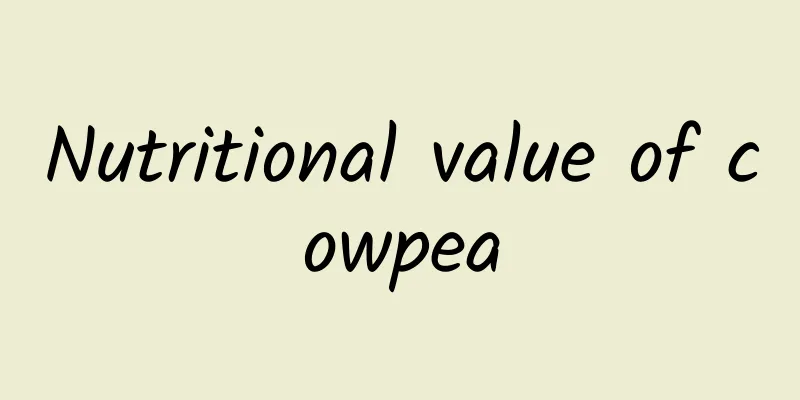Nutritional value of cowpea

|
Cowpea is a very good vegetable and a very common home-cooked dish. So what nutritional value does cowpea have? Let me tell you about it: Introduction of cowpea:Cowpea, also known as long bean, rice bean, beans, carob, kidney bean, and milk bean, is the tender pod shell and seeds of the legume plant cowpea. It is cultivated in most parts of the country. The fruit is harvested in autumn when it matures. Its roots, leaves, and pod shells are also used for medicinal purposes. Its leaves are mainly used to treat gonorrhea, its shells are mainly used to treat abdominal pain and lack of milk, and its roots are mainly used to treat indigestion in children. "Compendium of Materia Medica" says: "This bean can be used as a vegetable, fruit, or grain. It is the most reserved and is the best among beans." It also says that cowpea can "regulate the middle and replenish qi, nourish the kidney and stomach, harmonize the five internal organs, regulate the blood, produce essence, stop thirst, stop reversal, diarrhea, and promote urination." It has the effect of strengthening the spleen and stomach, and can be used as an auxiliary diet therapy for spleen and stomach weakness, diabetes, frequent urination, spermatorrhea, leucorrhea, and diarrhea. Cowpea pods have the effect of relieving pain and swelling. Cowpeas are divided into two types: long beans and rice beans. Long beans are generally eaten as vegetables, which can be stir-fried or blanched and served cold. Li Shizhen said, "This bean can be used as a vegetable, a fruit, or a grain. It is best to keep it as a reserve. It is the best among all beans." Cowpea is a long pod of the genus Vigna in the Fabaceae family. It originated in Africa, with its diversity center in Nigeria. After being introduced to India, cowpeas formed short-pod cowpea species; in Southeast Asia or China, the Yangtze River cowpea subspecies was formed. Cowpea is widely distributed in tropical and subtropical regions. Cowpea has a long history of cultivation in my country and is rich in resources. Cowpea grows in all provinces and autonomous regions except for a few provinces. The main producing areas are Henan, Shanxi, Shaanxi, Shandong, Guangxi, Hebei, Hubei, Anhui, Jiangxi, Guizhou, Yunnan, Sichuan and Taiwan. Cowpeas have high nutritional value. They contain high-quality protein that is easily digested and absorbed by the human body, an appropriate amount of carbohydrates, and a variety of vitamins and trace elements, which can supplement most of the nutrients needed by the body. Moreover, cowpeas are neither cold nor dry, so they are very beneficial as daily food. In addition, cowpea seeds can be used as medicine, which can also help to strengthen the stomach, replenish qi, nourish and digest food. Nutritional information of cowpea:100 grams of cowpea seeds contain 11.29 grams of water, 20 grams of protein, 1.2 grams of fat, 58.6 grams of carbohydrates, 7.3 grams of crude fiber, 2.5 grams of ash, 743 milligrams of potassium, 5.8 milligrams of sodium, 40 milligrams of calcium, 36 milligrams of magnesium, 344 milligrams of phosphorus, 8 milligrams of iron, 1.2 milligrams of manganese, 3.2 milligrams of zinc, 2.1 milligrams of copper, 5.74 micrograms of selenium, 0.06 milligrams of carotene, 0.16 milligrams of thiamine, 0.08 milligrams of riboflavin, and 9 milligrams of niacin. Nutritional value analysis of cowpea:1. Cowpea provides high-quality protein that is easy to digest and absorb, an appropriate amount of carbohydrates, and a variety of vitamins, trace elements, etc., which can supplement the body's signature nutrients. 2. Vitamin B contained in cowpea |
<<: How to make delicious cowpeas? Detailed steps for making egg-flavored cowpeas
>>: Steps for stir-fried cowpea
Recommend
The effects and functions of oatmeal. Who should not eat oatmeal?
Oatmeal is a healthy food with high fiber and low...
The efficacy, effects and contraindications of tangerine seeds
Tangerine seeds are a traditional Chinese medicin...
How to eat crabs? Which parts of crabs cannot be eaten?
Crabs are nutritious and delicious seafood ingred...
Can grape seeds be eaten? What are the benefits of eating grape seeds?
Many people like to eat grapes, but they often sp...
How to make casserole mushroom chicken soup
Food cooked in casserole is very fragrant because...
How to make honeydew melon sago soup
How much do you know about honeydew melon sago so...
How is the Norwegian University of Life Sciences? Norwegian University of Life Sciences reviews and website information
What is the website of the Norwegian University of...
How to eat bird's nest? Tips on eating bird's nest
Bird's nest is a delicious and extremely nutr...
Efficacy and function of elephant ivory ginseng
When you see the name of elephant tusk ginseng, d...
Ginkgo Beauty Porridge
Ginkgo beauty porridge has always been popular am...
How to make braised spare ribs How to make braised spare ribs delicious
Braised spareribs is a famous dish in many restau...
What is the American Bureau of Shipping? American Bureau of Shipping reviews and website information
What is the website of American Bureau of Shipping...
The efficacy and contraindications of saffron
Safflower is an annual herb and the whole plant c...
What are the benefits of eating Torreya grandis for women? Who is not suitable to eat Torreya grandis
Torreya grandis is a kind of nut food. It is espe...
When is the best time to drink pure milk? Which brand of pure milk is good?
Pure milk has the highest nutritional value among...









